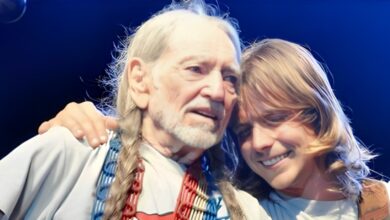Webb Pierce’s Unforgettable Performance of “There Stands the Glass”
The song “There Stands the Glass” serves as a poignant exploration of heartbreak and the human condition, a theme commonly found throughout the annals of country music. The lyrics unfold a narrative that delves deep into feelings of loneliness and despair, illustrating how alcohol can serve as both a comfort and a source of further anguish. The imagery woven into the song is vivid and relatable, capturing the essence of longing and the struggle for emotional relief. For many listeners, the song resonates on a personal level, reflecting their own experiences with love and loss, and the often complicated relationship with substances used to numb pain.
The collaborative effort of Russ Hull, Mary Jean Shurtz, and Audrey Grisham in writing this song highlights the power of teamwork in crafting music that speaks to the core of human emotion. Their ability to conjure a sense of vulnerability within the lyrics sets the stage for listeners to engage with the narrator’s plight. The song commences with an evocative sense of yearning, establishing a clear connection between the narrator’s inner turmoil and the soothing, albeit temporary, presence of the drink at hand. This duality—of seeking solace while grappling with incessant heartache—underscores the complexity of the emotional landscape, making the song a rich narrative experience.
As a defining figure in 1950s country music, Webb Pierce brought his unique vocal style and emotional delivery to “There Stands the Glass.” His distinguishable voice captures the raw emotions embedded in the lyrics, allowing listeners to share in the narrator’s sorrowful journey. Through the use of traditional country music instrumentation, such as the resonant steel guitar, Pierce’s arrangement adds an additional layer of depth, enhancing the emotional weight of the song. This combination of heartfelt expression and instrumental prowess significantly contributed to the song’s place within the country music genre.
The metaphor of the “green-hued liquor” found in the song’s lyrics serves as a powerful symbol of temporary relief from overwhelming emotional pain. Such themes of seeking comfort in alcohol resonate widely in country music, where protagonists often find themselves entangled in struggles with love and loss. The song effectively juxtaposes its poignant lyrics with a compelling melody that draws empathy from the audience, transforming a personal story of suffering into a shared human experience.
Upon its release in 1953, “There Stands the Glass” quickly climbed the Billboard country charts, marking a significant milestone in Webb Pierce’s career and solidifying his status as a leading country artist. The immediate success of the song resonated not just with Pierce’s fanbase but also within the broader music community, prompting numerous artists to cover the song, each interpreting the material through their unique lenses. These renditions further cemented the song’s legacy, ensuring its continued relevance in the ever-evolving landscape of country music.
Today, the enduring themes of “There Stands the Glass” remain pertinent, as the emotional struggles expressed within the lyrics continue to echo the experiences of contemporary audiences. As a classic, the song frequently surfaces in live performances and radio airtime, encapsulating timeless sentiments surrounding lost love and the fraught search for reprieve. The universal nature of these themes ensures that “There Stands the Glass” is not merely a relic of the past but a living piece of art that continues to connect with listeners.
Webb Pierce’s own legacy is notable, as he carved a niche for himself with numerous hits that dominated the country music scene in the 1950s and 1960s. His work has earned him a revered place in country music history, with songs that were rich in narrative and emotional texture. Hits like “In the Jailhouse Now” and “Wondering” reinforced Pierce’s influential role in shaping the sound of honky-tonk music, a genre characterized by its storytelling and authentic emotional expression.
Pierce’s profound ability to convey emotion through his music set a benchmark for future generations of artists, encouraging a focus on lyrical storytelling that continues to define country music today. As emerging artists draw from his extensive catalog, “There Stands the Glass” serves as an exemplary study in emotional resonance, illustrating the power of music to articulate complex feelings and experiences. The song emphasizes the significance of understanding and grappling with human emotions, encapsulating themes that transcend time and speak to the heart of many.
The cultural impact of “There Stands the Glass” within country music and beyond is substantial. The song not only represents a peak in Webb Pierce’s illustrious career but also serves as a reminder of the genre’s capacity to address deeply personal and societal challenges. Through its exploration of heartache and the quest for solace, the track invites listeners into a shared space of introspection and empathy, solidifying its status as a timeless staple in the legacy of country music.
In a genre frequently steeped in personal storytelling, “There Stands the Glass” stands out for its poignant portrayal of sorrow and vulnerability. It remains an essential piece of work that encapsulates the spirit of human resilience in the face of emotional strife. The ability of Webb Pierce and his collaborators to transform personal pain into a universally relatable experience showcases the enduring nature of great music, which continues to resonate through generations, reminding us of our shared humanity amidst life’s ups and downs.





